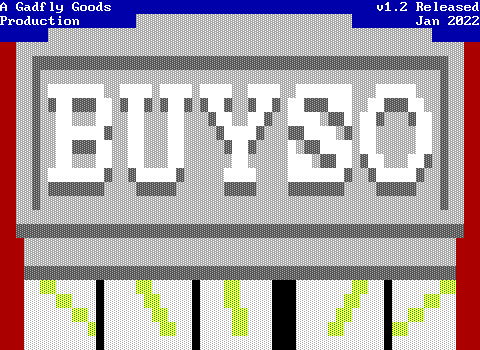Let us return to a world of swords and sorcery!
Or, I guess more accurately, a world of guns and snake people (sneople).
A few months back, I opted to take a look at Castle of Zandia, getting some insight into how renowned ZZTer/MZXer Jeremy LaMar got his start. I found myself really charmed by the game, clearly made by a new ZZTer, but also clearly made by someone who had a lot of good ideas that ZZT was allowing to be made a reality. For a first entry, Castle of Zandia was a very promising start to a journey whose conclusion was already known to be one of ZZT's (and MegaZeux's) most fulfilling.
I figured it was about time to check out the game's sequel, Kingdom of Zandia, to see the next stop on LaMar's path to Ned, and entered with high hopes. I was expecting more of everything. More polish,more story, more to explore, more puzzles more action, and more of the animation LaMar was famous for.
What I got wasn't quite what I had in mind, and perhaps my sights were set too high for a direct sequel to a first foray into ZZTing. Holding LaMar to a more reasonable standard however, and Kingdom does build on the original game, laying a clear foundation for Ned the Knight with its themes and set pieces. I wanted everything I asked for and more, receiving instead a sequel which does feel more developed, does bring in new ideas and gameplay styles, while also leaving some aspects of the original behind.
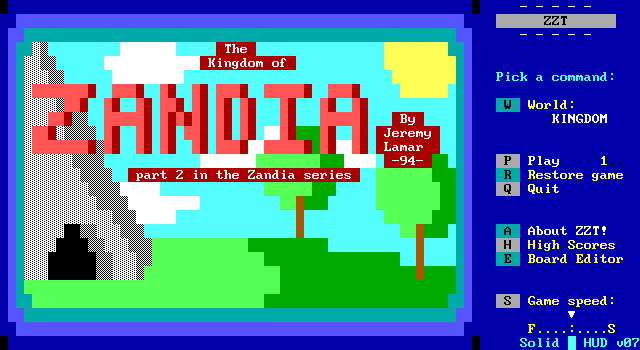
Bad Dates
Almost immediately there's an issue here. The file's date suggests the game originates from May of 1996, but the title screen says 1994. Is this merely a re-save of the original or is this an updated revision to the world? It's made even more challenging by the fact that the Museum does have another later release of the game where the title screen has been updated to say 1997. This is part of a package that also includes the first Zandia game with its title screen also displaying 1997. The only changes made in these two releases is the text on the title screen. Whether or not this version is truly 1:1 with the original or not gives the game some ambiguity when it comes to figuring out where exactly LaMar was skill-wise.
Needless to say, trying to divine accurate dates when it comes to ZZT is an exercise in frustration.
Seeing the May 1996 date of the older file before actually paying attention to the title screen can radically change one's expectations. If there was in fact well over a year between releases, there would have been plenty of time for author Jeremy LaMar to improve his game making skills. The expectations get even greater when you realize that October of 1996 is the (firmer) date on record for when LaMar's Ned the Knight was released. Putting Kingdom of Zandia so close to one of ZZT's seminal works can really mess with the idea of what to expect compared to the likely truer release date being as little as a month after the original game.
1994 is surely more accurate, and transforms the expectations dramatically. It makes the game something LaMar must have started almost immediately after Castle, which if its own date is trustworthy means barely a month left in 1994 to develop it over.
An Old Threat And a New One
Kingdom is a direct sequel to Castle. The first game ended pretty cleanly, with its antagonist, the evil king, being defeated at the hands of Ralph the hero. There was no sequel hook or ambiguity to the ending to entice players for the next chapter of the story. Even so, Castle had a limited scope for the game world, which LaMar definitely had plenty of ideas for. The first game had its share of NPCs that were also hoping to bring down the king, with no hint at what they did outside of the castle. Then of course there were the variety of evil villains aligned with the king, establishing the world as one with some pretty clear divides between good and evil.

So it's not really a stretch to imagine a sequel. LaMar includes his share of callbacks to the first game, while focusing on a more "wake up and save the world" setup, with Ralph just going about his day before stumbling onto a new adventure. Something seems slightly off in town though. A guard has been posted at the gates refusing to let anyone leave, and some villagers are hiding to keep from being noticed. Even poor Timmy, the little boy and Ralph's next door number is struggling to scale the walls to retrieve a missing ball.
Ralph sets out to investigate, which doesn't take too long as LaMar keeps the game focused, with little to distract players from their immediate goal. After having dealt with the slow opening of exploring a large town with so many people to talk with only for nothing of note to be discovered back in Nature's Revenge, not having to enter any buildings but the one that advances the game is a welcome change of pace. The zippy nature continues as Ralph digs up a key to the mayor's office and quickly discovers what's going on when he finds not one, but two identical looking mayors.
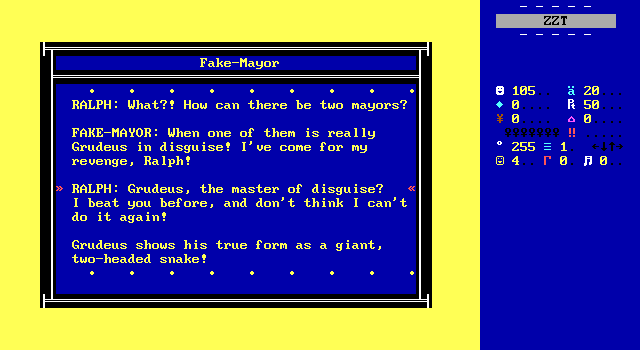
The fake mayor wastes no time, revealing themselves to be none other than Grudeus, the two headed serpent and master of disguise seen in the previous game. I was so excited to hear that Grudeus was back. The cast of characters in Castle was a highlight of the game, with Grudeus being a personal fave thanks to his great name.
With Grudeus having been dealt with before and merely being a flunky of the evil king, the fight keeps up the fast pacing, with Grudeus running off after a mere three hits. This is the first time the player gets to do some shooting, so it's nice to not be overwhelmed from the very start. This sets up the player with a goal to apprehend Grudeus before he can cause more trouble, though it won't be long before Ralph's goal changes entirely.
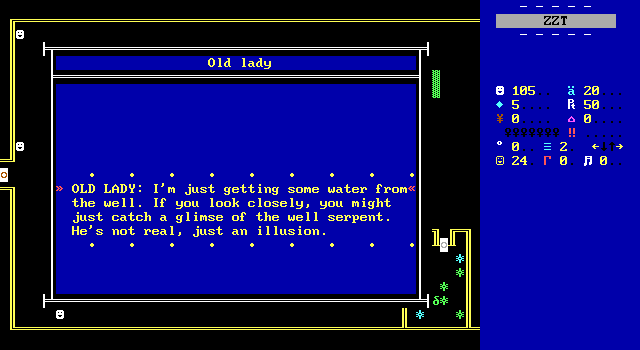
An old legend speaks of a serpent in the town well which after rescuing the real mayor the player is able to drain and explore thanks to a magic spell. After fighting through some of Grudeus's own grunts on this beautiful board of the not fully-drained well, Ralph meets the serpent who immediately throws a wrench into Ralph's plans.
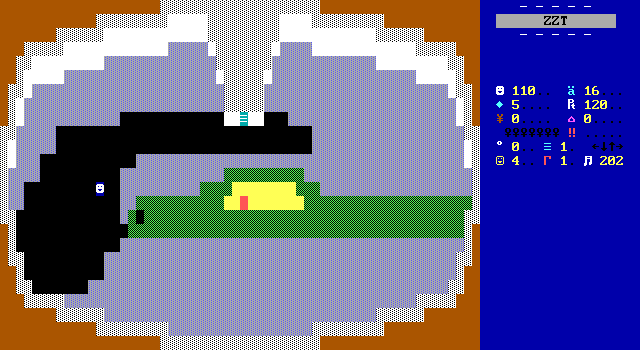
This serpent is no foe, but they have a surprise revelation: a greater evil has arrived, and only Ralph can defeat them. In order to do so, he'll need the help of none other than Grudeus!
As it turns out, Grudeus has been under the effects of a curse all this time, and by shaking some powdered snake scales on him, he'll return to the side of good once more. The search for Grudeus continues with a new motivation for finding him. Again, as a Grudeus fan, I was so on board for this, cheering to no one about the now inevitable Grudeus redemption arc.
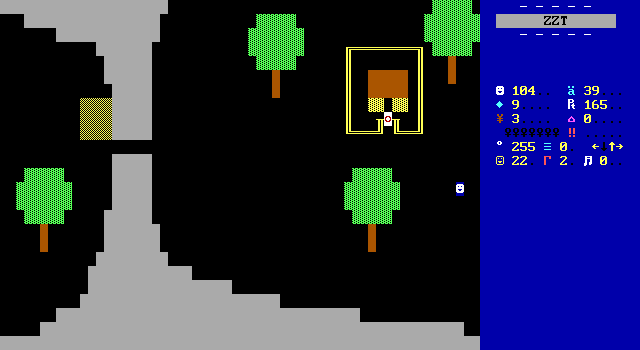
Now able to leave town, Ralph's new quest can begin, with the kingdom of Zandia differing from the castle as it takes a somewhat more open-ended design. The overworld is broken up into a few different sections where players usually gain access to a handful of boards to explore, fight some lions and centipedes, and some obstacle that requires something to get past. These obstacles are sometimes as simple as using ZZT's keys and doors, though the more interesting ones are when LaMar comes up with something more distinct like walls that require explosives or a demon that can only be defeated by coming into contact with rubber. (Remember Timmy who lost his ball? It's a good thing he did actually.)

Ralph does eventually manage to free Grudeus from his curse, after successfully infiltrating his fortress and dealing with a few of his goons. This leads to a wonderful scene where the now good serpent turns on his still evil minions, taking them all out effortlessly while confusing the hell out of them. Putting their past behind them, the two travel together with Grudeus helping out not as you might expect with his skills in disguising, but his sheer brute strength. He smashes a rusted gate that prevents Ralph from heading northward, and throughout the rest of the adventure routinely bashes barriers for Ralph. It's kind of his thing.
He's not just a one note character though. There's plenty that Grudeus knows about the world that Ralph doesn't. When times are dire, Grudeus can be counted on to know what to do. It's great seeing him taking such a prominent role in game. At one point, he even defeats one of the game's bosses himself! normally, I'd be let down at an NPC getting to do the fun part while the player just watches, however there are plenty of boss fights across the adventure, and aside from the final gauntlet they play similarly enough that it doesn't sting so much to miss out.
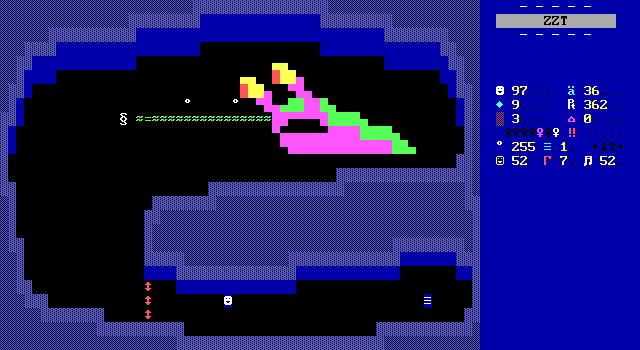
This is helped immensely by LaMar's love of animation, as watching Grudeus fight isn't just one object spamming #shoot e while the other spams #shoot w. Instead, Grudeus attacks with not just bullets, but energy blasts and laser beams as well. If anything, it highlights the weakness of ZZT's combat seeing these much more exciting bursts of color that look really cool, but are impractical to try implementing into a fight in which the player gets to participate. They're the sort of effects you'd see from ZZT RPGs rather than its action titles. Putting them into a cut-scene at least lets players experience the excitement vicariously. ZZT's limitations finally give a good reason for a game to make you watch something rather than participate directly in it: There's no way for the engine to handle player participation in such a scenario.
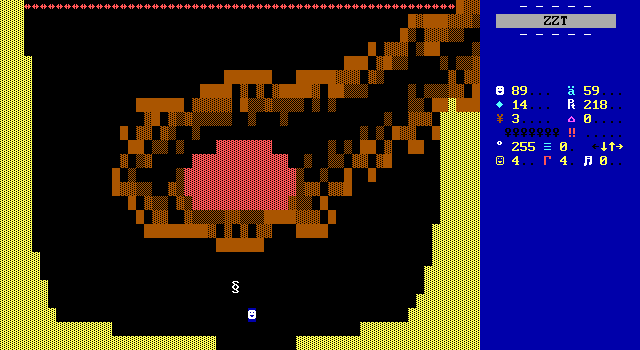
With Grudeus now on the side of good, LaMar needs to introduce a new character to take on the role of villain.
This time, the villain is extraterrestrial in origin. A comet has crashed down nearby bringing two threats along with it. Firstly, the comet itself which is emitting a strange radiation that has been causing mutations in the local flora and fauna. This is the source of most of the game's bosses, with plants, insects, and slugs growing to tremendous size and wreaking havoc on anyone that crosses their path. These again cater to LaMar's cartoony style, with each of the boss battles being a sight to behold, whose specifics we'll get into later on.
The radiation, dangerous as it may be, is merely an unfortunate side effect of the impact. The real threat comes from the being that hitched a ride on the comet, a goopy purple blob-like alien named Raigiss. Raigiss's plans are never really explored. I can only assume world conquest starting with Zandia. He is powered by the comet, and after the crash is in a weakened form. That will change by the end of the game with him growing to a size that eclipses the mutants fought leading up to the encounter with power to match.
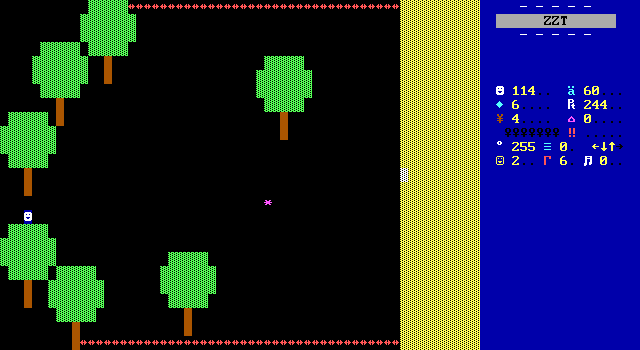
Even in his weakened state, Raigiss is no joke. He manages to brainwash Grudeus, toying with my heart as I began to fear the Grudeus un-redemption arc that was sure to follow.
Connecting Past and Future
The original Castle of Zandia, was a fun experience, but lacked a lot of what ZZTers think of when they think of LaMar. Still too early to have developed much of his own personal style, the first game felt more derivative of games from ZZT's Revenge. The hallmarks of detailed animations, oversized characters, and colorful art hadn't yet become core parts of LaMar's toolkit.
Despite this game seemingly being produced so soon after its predecessor, all of those aspects are now here, and in some cases are even as impressive as those in Ned the Knight.
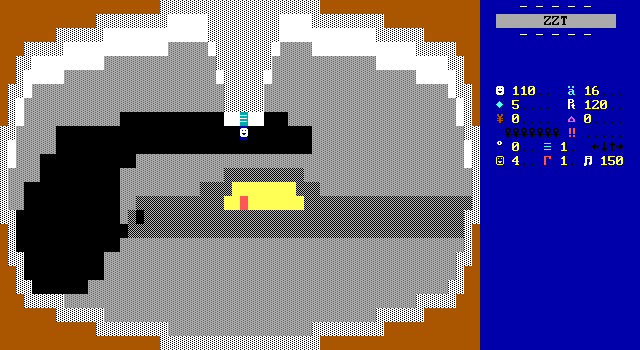
Shortly after players complete their first encounter with Grudeus, players obtain a magic spell that allows them to drain the town well. A local legend suggests that the well is protected by a giant serpent that will one day help a hero save the kingdom.
Sure enough, the legend is true, and players are treated to a glimpse of the snake's head poking out above the water's surface at the bottom of the well. Compared to the more lavish designs seen in Ned The Knight, it's not the most impressive sight to behold, but it marks that first step of LaMar's journey to reaching that level of impressive visuals.
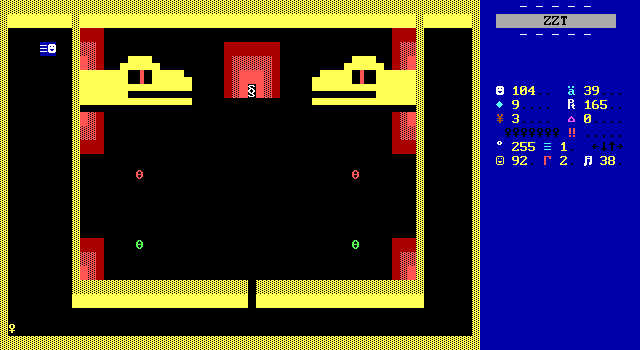
But the serpent is merely the beginning. On Ralph's adventure, I found myself constantly being surprised with giant character art, and a touch of surprisingly elaborate decorations that could very well have been used for characters. Seeing this level of detail in what would otherwise be a typical new ZZTer's take at an adventure adds such a sense of excitement as you explore. Any time a character is spoken of, you get to look forward to seeing how LaMar portrays them, and even when there's no new foe to deal with, the fact that sometimes LaMar puts in the same amount of effort on bog standard boards means any transition to a new screen is an opportunity to be wowed.

In one instance, LaMar trots out his own homemade STK graphics to gain limited access to colors beyond ZZT's default seven. Prior to the early 1994 release of STK, which took some time to spread to all ZZTers, a handful of games instead rolled their own. By changing a few of ZZT's default elements that used normally inaccessible colors it was possible to create other elements using those colors. This, combined with the more common approach of getting dark solid walls by using ZZT's text and just placing space characters, is used throughout the world, giving the game an unusual look where I kept second guessing myself as to whether the game was making full use of STK or not.
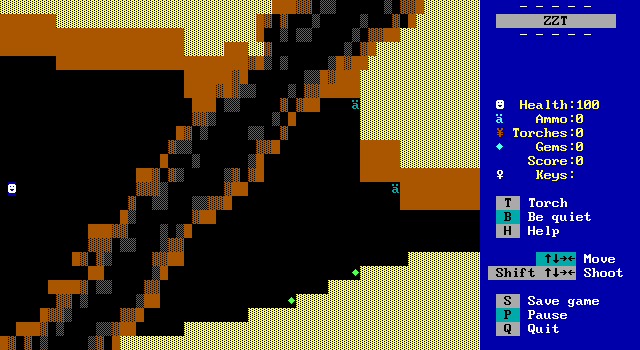
On this board in particular, torches get turned into walls to better sell the displaced dirt that marks the comet's crash landing. As soon as players enter, the graphics are updated to provide some finer details in a color ZZT's editor doesn't allow authors to choose.
Ralph Speaks

Something unexpected from what you might think of when you think of Lamar's works is how much this game favors explanation over interaction. The game starts players in Ralph's house which to me, screams Aceland, albeit with some actual furniture inside rather than just items to collect.

As each of the outer rooms is entered, the player will bump into a hidden object next to each doorway popping up some text from Ralph addressed to the player about what each room is and what it's for. There's nothing too exciting to learn as the house is pretty straightforward. What's more unusual is that not one of the objects can be touched. Players have to intuit cabinets, tables, the obligatory toilet, and anything else based solely on Ralph's description of each room.
This low-interactivity persists throughout the entire game. It really breaks away from the usual ZZT style of explaining everything to players when it's touched, and the lack of it is felt once outside of Ralph's home. Even if these objects are purely decorative, there's a fuzziness to them the moment Ralph enters a location that isn't as common in ZZT as a home.
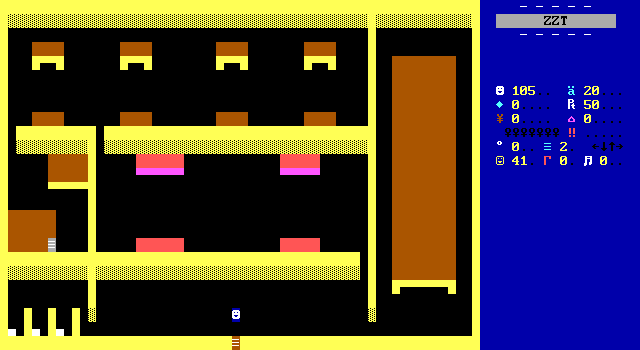
The mayor's office, for example, uses Ralph's dialog upon entering a room to point out large tables in meeting rooms and couches in the lobby among other things.
In the lower left corner, what I guessed was going to be some archival room of records turned out to be a public restroom with stalls.
I suspect this is mostly LaMar not wanting to spend too much time on the boring parts. Ralph's home and the mayor's office are over and done with almost immediately, and only have all these things included for the sake of mimicking such spaces in real life. The focus on Kingdom is of the larger world that surrounds these tiny interiors, so why waste time writing a message just to confirm "desk", "chair", or "toilet" when Ralph never needs to do anything with these items?

As the game progresses, Ralph's words for the player begin to feel more acceptable. Ralph can communicate his innate knowledge of the world to players, and the world can be kept free of clumsier things like directly labeling buildings (though the mayor's office is...) or having a signpost that says "VILLAIN'S HIDEOUT ---> THIS WAY".
Essentially, I feel like Ralph's commentary is a net positive, though the lack of objects to interact with left me wishing I had more to do. Nearly every board in Ned the Knight has several things for players to investigate. Kingdom of Zandia is still significantly more interested in the action than potential exploration.

